New limited editions from Second Sight, part one
I spent some time in December binging six new limited edition releases from Second Sight, only two of which were movies I hadn’t seen before, the others being upgrades of older DVDs or Blu-rays. This is definitely a habit I need to curtail now that I’m retired and have to keep a closer eye on spending … but in each case, I ended up revising my opinion to some degree; I’m never sure whether this is a result of the psychological effect of fancy new packaging or an actual shift in my understanding of what I’m watching. But first, the two films new to me:

Frankenstein and the Monster from Hell (Terence Fisher, 1974)
Although Hammer Films had been around since 1935, when the small company began making modest quota quickies, and had begun to make a real mark in popular culture with its feature versions of BBC television productions in the mid-’50s, it really became the company we now know with the release of The Curse of Frankenstein in 1957. This colour version of the familiar story of a doctor determined to create a better human being from parts of dead bodies was shocking at the time as it pushed the limits of what British censors were willing to allow on screen in terms of gore and violence. The film’s success didn’t immediately change the company’s trajectory, and despite the impression given by a long run of Gothic horrors, Hammer continued to produce movies in a fairly wide variety of genres. But it was the Gothics which gave it a lasting identity in the public’s perception.
In this respect, it’s impossible to over-estimate the influence of director Terence Fisher, who established the look and mood of those films, despite not having any deep personal affinity for the genre. He was more interested in the romantic aspects of the Gothic tradition, something which he was only occasionally able to bring to the material assigned to him. In the event, he made sixteen Hammer Gothics of varying quality, and it’s perhaps fitting that his final film should also have marked the conclusion of the studio’s efforts in this line (there were two other horrors before the company closed shop, but neither belonged to the pure Gothic: Roy Ward Baker’s The Legend of the 7 Golden Vampires [1974] was an awkward amalgam of European horror traditions and Shaw Brothers martial arts, while Peter Sykes’ To the Devil … a Daughter [1976] was a not entirely successful attempt to update Dennis Wheatley’s Satanic stories in a post-Exorcist environment).
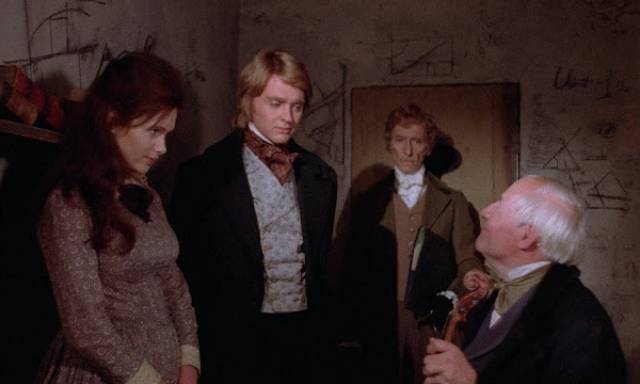
Frankenstein and the Monster from Hell (1974), which I somehow had missed seeing over the past fifty years, rather pointedly looks back to its roots, eschewing the studio’s ramped up efforts to reinvigorate the genre with injections of nudity and sex since Roy Ward Baker’s The Vampire Lovers (1970) had discovered the box office value of mixing blood-drinking and lesbianism with its very loose adaptation of Joseph Sheridan LeFanu’s “Carmilla”. Fisher’s swansong, scripted by producer Anthony Hinds, is a kind of throwback to The Revenge of Frankenstein (1958), the second and best film in the series, but now with an almost melancholy view of what has so obviously been exposed as a misguided and futile dream. After years of unsuccessful attempts to produce an improved human, the Baron is broken and consumed by his own madness.
But before we meet him again, the film introduces a young doctor named Simon Helder (Shane Briant) who has come into possession of Frankenstein’s notebooks and is trying to repeat his experiments. When the police pursue a bodysnatcher to Helder’s garret and discover a litter of body parts, the doctor is arrested, tried and sentenced to an asylum for the criminally insane, a gloomy Gothic structure with an unsavoury director (John Stratton) who leaves the running of things to his brutal underlings while he spends his time abusing young women.
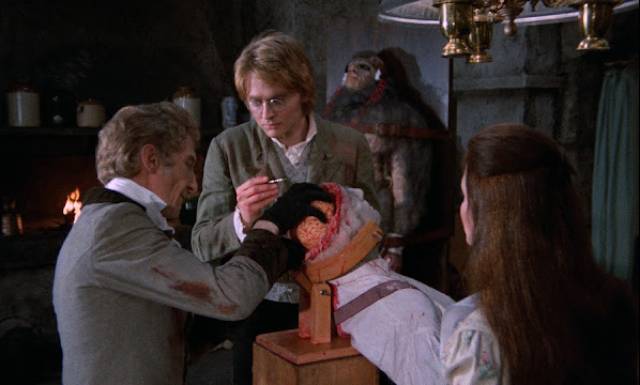
It’s only after Helder himself has been brutalized that we finally see Frankenstein (Peter Cushing in his final appearance as the mad scientist). Reportedly dead, he now has an assumed identity and is in fact running the asylum, having turned it into his own private laboratory. Older now, and frail, with crippled hands, he does his experiments with the help of a mute inmate named Sarah (Madeline Smith), who performs surgery under his direction. Sarah’s condition and identity provide a counterbalance to the Baron’s obsession as it slides inexorably into cruelty and sadism. It becomes clear that he is using the inmates as a source of raw materials, killing them as needed and harvesting their bodies for parts.
Helder befriends Sarah and insinuates his way into Frankenstein’s secret lab, where after initial hostility he is recruited as an assistant – and eventually successor. All of this works as a fitting conclusion to the Baron’s story, but in an attempt to add something new Hinds and Fisher made an oddly disconcerting choice by making the new creature not the usual pieced-together patchwork but, somehow, a hulking prehistoric brute, a Neanderthal giant in a fur suit. There’s no convincing explanation for this and certainly no narrative rationale given the Baron’s aim to create a superior form of human being. This body overwhelms the sensitive brain which is installed after Frankenstein kills a gentle, cultured inmate, and it inevitably goes on a rampage.
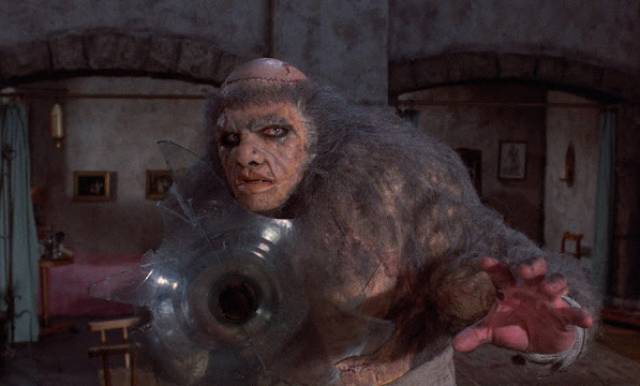
The deficiencies in the creature (played by David Prowse a few years before donning the iconic black armour of Darth Vader) are partly a sign of the film’s budgetary constraints, as are the obvious model of the asylum in its tabletop landscape, far less convincingly shot than the various castles and mountain crags of the company’s earlier Gothic movies. And yet the film is nonetheless quite satisfying, giving Hammer’s seventeen-year Frankenstein saga a fitting conclusion.
Second Sight’s Blu-ray has an excellent transfer – in both 1.66:1 and 1.37:1 framing – of the slightly longer UK cut (Paramount trimmed it by 1.5 minutes in the States). There’s a new Kat Ellinger commentary and an archival one with Hammer expert Marcus Hearn and actors Shane Briant and Madeline Smith. David Huckvale appears in two featurettes, one about the movie in general, the other on James Bernard’s score. There are also a couple of archival featurettes about the making of the film and Fisher’s career, plus a 48-page booklet of essays and a set of five postcards contained in an attractive slipcase.
*

Green Room (Jeremy Saulnier, 2015)
I was aware of Jeremy Saulnier’s Green Room (2015) mostly because it was one of the few significant non-Star Trek movies starring Anton Yelchin before his early death in a freak accident. I also recall having heard about Saulnier’s previous film, Blue Ruin (2013), though I still haven’t seen it. All I knew about Green Room was that it was a punk band-versus-Nazis story with a backwoods setting, which sounded vaguely interesting but somewhat generic. But I nonetheless added a copy to my Second Sight order because I have weak impulse control when shopping on-line.
I’ve seen quite a few movies about unsuspecting characters who find themselves travelling off the beaten path and running into dangerous hostile locals, so I expected the movie to follow a familiar path – and it does that, but what Saulnier adds is a surprising amount of character nuance and some extremely well thought out narrative details. The film is a thoughtful examination of two social outgroups clashing in a context of escalating violence which forces the characters to face the consequences of the particular choices they’ve made about how to define themselves. There’s an inherent tension between authenticity and the performative aspects of identity, the attitudes and behaviours taken on to fit in with a chosen group.
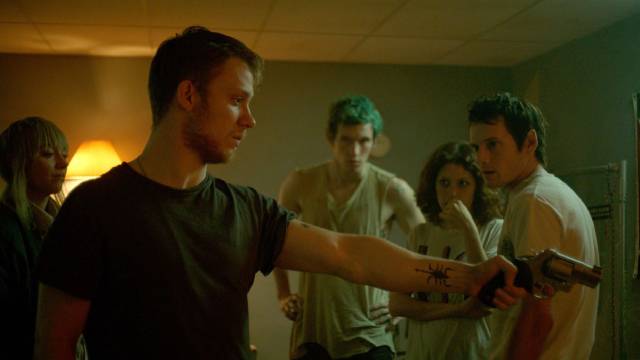
When the band members are first introduced, they seem a little obnoxious, not to mention pretentious, in their condescension towards an admirer who’s interviewing them. That pretension is deflated when it turns out that the venue for an upcoming performance is a nearly empty restaurant with a few disinterested customers. Their connection offers them another gig, but it may be problematic – it’s a club out in the country populated by skinheads. Somewhat angry and resentful, the band choose to open their set with a cover of the Dead Kennedys’ “Nazi Punks Fuck Off”, which naturally triggers some hostility – though that in itself fits well with the punk aesthetic.
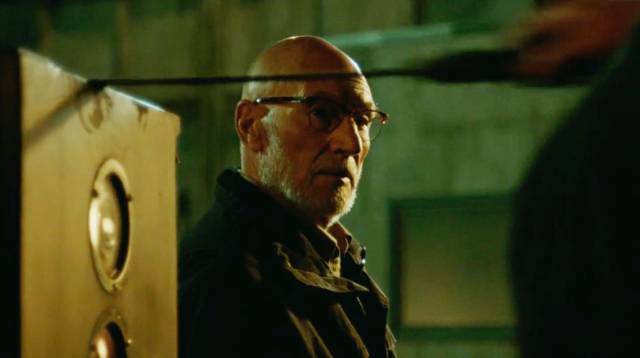
Things go bad when, as they’re preparing to leave, they witness a killing in the green room. One of the Nazis has stabbed a woman in the head because she was planning to dump him and leave with another man who’s tired of the while skinhead thing. The band members are locked in while the Nazis’ leader is notified. This turns out to be an older man (Patrick Stewart playing chillingly against type) who, it becomes clear, is using the skinheads’ alienation and anger for his own purposes. When the band members realize they’re not going to be allowed to leave alive, they have no choice but to fight back and the film becomes a tense, claustrophobic siege with an escalating body count, characters on both sides forced to make disturbing choices and either dig into their assumed personas or jettison them for something more authentic in order to survive.
Saulnier wraps this core narrative in a lot of telling detail, using well-constructed action sequences through which the characters are revealed by stripping away successive layers of self-definition and delusion. The writing, direction and performances are impeccable.
The dual-format edition naturally has an excellent transfer – digitally shot, it has a darkly atmospheric image – with a pair of commentaries and a number of new and archival interviews. In addition, there’s a 120-page book of essays and a set of postcards.
*
In the next post, I’ll cover the four Second Sight upgrades.
Comments